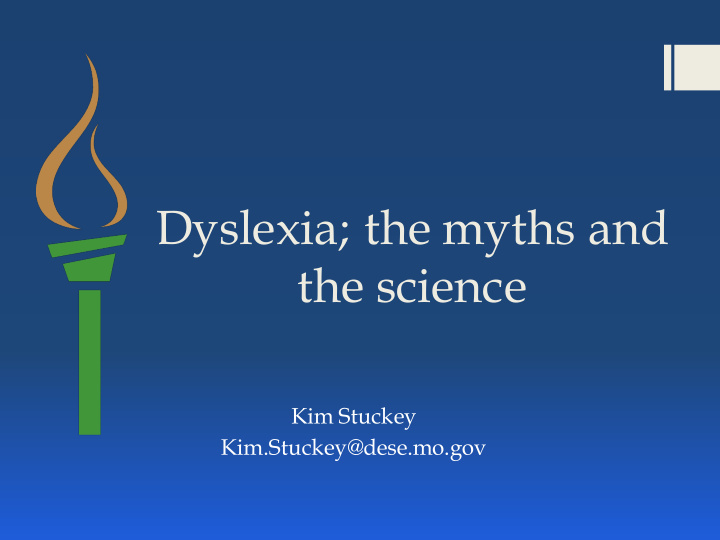



Dyslexia; the myths and the science Kim Stuckey Kim.Stuckey@dese.mo.gov
Learning Intentions Debunking myths Defining Dyslexia Review mandates and requirements
Debunking the Myths Myth: People with dyslexia see letters or words backwards. Fact: Dyslexia is an issue with processing and manipulating language.
Myth: IQ = Skilled Reader Fact:
Myth : Dyslexia affects more boys than girls. Fact : Statistically, dyslexia affects them about equally. Myth : Dyslexia is rare. Fact : Dyslexia represents the most researched and most common of all learning disabilities; affecting 7-15% of the general population and approx. 80% of students in Special Education for reading. (NICHS, 1994)
Myth : Students with dyslexia just need more practice reading. Fact: Spending more time attempting to read will not address poor phonological awareness or improve word recognition skills.
Myth: Students will eventually outgrow dyslexia. Fact: Dyslexia is life-long. Many people with mild or moderate dyslexia learn to compensate for their weaknesses in ways that those around them wouldn’t suspect they have struggles.
Dyslexia is.. • neurobiological in origin • characterized by difficulties with accurate and/or fluent word recognition and by poor spelling and decoding abilities • difficulties typically result from a deficit in the phonological component of language • difficulties often unexpected in relation to other cognitive abilities and the provision of effective classroom instruction • secondary consequences may include problems in reading comprehension and reduced reading experience that can impede growth of vocabulary and background knowledge. IDA/NICHD, 2002
Inside the Definition difficulties typically result from a deficit in the phonological component of language Phonological awareness is the umbrella of skills including alliteration, rhyme, syllabication, identification, categorization, blending, segmenting and manipulating language sounds
Inside the Definition accurate and/or fluent word recognition and by poor spelling and decoding abilities Poor phonological awareness impairs a students ability map sounds to print. This means more time spent decoding unknown words and many more exposures to build fluent word recognition skills, as well as poor spelling ability.
Inside the Definition difficulties often unexpected in relation to other cognitive abilities and the provision of effective classroom instruction Students often appear bright in other areas, oral comprehension and general intelligence are average compared to peers.
Inside the Definition secondary consequences may include problems in reading comprehension and reduced reading experience that can impede growth of vocabulary and background knowledge . Laborious decoding and poor word recognition mean less fluency, lower comprehension and eventual avoidance of reading impacting vocabulary and background knowledge.
Pre and Post Intervention
Statute In the 2018-19 school year and subsequent years, each public school, including each charter school, shall conduct dyslexia screenings for students in the appropriate year consistent with the findings and recommendations of the task force created under section 633.420. "Dyslexia screening" is a short test conducted by a teacher or school counselor to determine whether a student likely has dyslexia or a related disorder in which a positive result does not represent a medical diagnosis but indicates that the student could benefit from approved support.
Guidance Screening Each student kindergarten through grade 3 each year. Grades 1-3 should be screened within the first 30 days of the school year, with follow up at the middle and end of the year for systematic documentation of progress or lack of progress. Kindergarten initial screening should occur no later than January 31st and also at the end
Statute In the 2018-19 school year and subsequent years, the school board of each district and the governing board of each charter school shall provide reasonable classroom support consistent with the findings and recommendations of the task force created under section 633.420. "Support" is low-cost and effective best practices, such as oral examinations and extended test- taking periods .
Guidance Lists of classroom supports listed on pages 6-9. The following is a list of example accommodations that benefit students with dyslexia. Note that not all students at risk for dyslexia will require all the possible supports. It is important to match and scaffold the supports with the student’s individual need.
Next Steps Implementation Planning Communication Building Level Teams Parents Training Opportunities Webinars RPDC’s
Thank you! Please tell us what you think. https://www.surveymonkey.com/r/OCCREvaluation
Kim Stuckey 573-751-2584 kim.stuckey@dese.mo.gov Edmodo Group Code: fsj36g
Resources Bowers, Peter, How the Written Word Works, 2010 Henry, Marcia, Unlocking Literacy, 2 nd Ed., 2010 Moats, Louisa Cook, Speech to Print, 2 nd Ed., 2010 Kilpatrick, David, Equipped for Reading Success, 2016 Kilpatrick, David, Essentials of Assessing, Preventing and Overcoming Reading Difficulties, 2015 Selznick, Richard, Dyslexia Screening, 2015
Recommend
More recommend